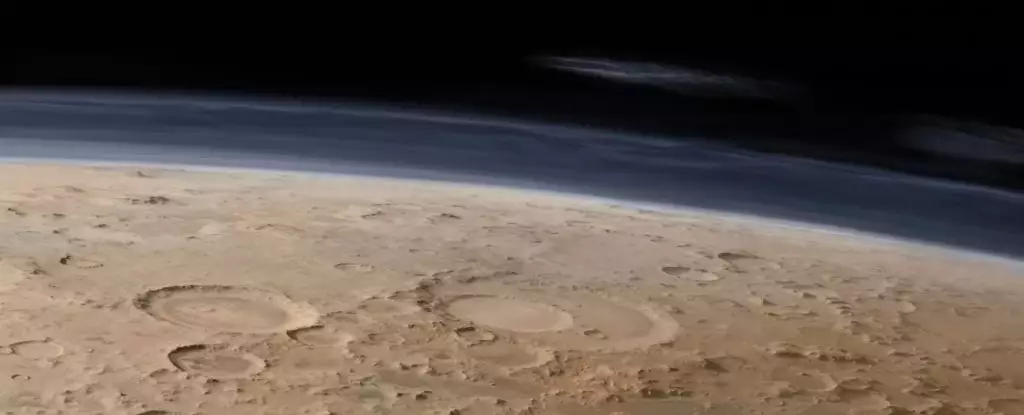The vast, desolate landscape of Mars has long intrigued scientists and astronomers alike. Understanding the fate of its atmosphere—and, consequently, its water—holds critical implications for the exploration of habitability beyond Earth. Recent groundbreaking research led by Shannon Curry at the University of Colorado Boulder has illuminated an underappreciated phenomenon known as atmospheric sputtering. After nine long years of satellite observations, the researchers have unveiled compelling evidence connecting this process to Mars’ atmospheric depletion.
Atmospheric sputtering is a complex mechanism whereby high-energy ions from the solar wind collide with an inert atmosphere. In the absence of a protective magnetic field, these collisions lead to atmospheric particles gaining enough energy to escape into space. This revelation could be pivotal in piecing together the historical timeline of Mars’ once-thriving wet environment, dissecting how it transformed into the desiccated planet we observe today.
Historic Observations: The Role of MAVEN
The primary sentinel in this quest to delve into the Martian atmosphere has been NASA’s MAVEN (Mars Atmosphere and Volatile EvolutioN) spacecraft, which has been orbiting Mars since September 2014. Equipped with sophisticated instruments, MAVEN has enabled unprecedented exploration of Mars’ upper atmosphere and provided invaluable data pertinent to atmospheric physics. The crux of the research involved scrutinizing this data for signs of atmospheric sputtering, with a specific focus on argon, an inert gas that serves as a reliable tracer.
Remarkably, the researchers discovered that above an altitude of 350 kilometers, variations in argon densities aligned with the dynamics of the solar wind. Such findings were previously unrecognized and challenge existing paradigms concerning the current state of atmospheric loss on Mars. By identifying a depleted concentration of lighter argon isotopes alongside an excess of heavier isotopes, the researchers confirmed that sputtering is indeed an active contributor to the ongoing erosion of Mars’ atmosphere.
The Solar Storm Connection
The research team’s breakthrough moment came during the analysis of data from a solar storm that occurred in January 2016. Their examinations revealed that the splintered solar energy had amplified the sputtering effects substantially, with current rates exceeding earlier estimates by over four times. This correlation suggests that during the planet’s formative years, when solar activity was more vigorous, sputtering could have played a profound role in Mars’ atmospheric history.
Such findings provide a speculative but tantalizing glimpse into the conditions that may have prevailed billions of years ago. Mars was not the barren landscape it is today; it was likely enveloped in a more robust atmosphere, fostering conditions suitable for liquid water—an essential ingredient for life.
Implications for Habitability
As researchers piece together the puzzle of Mars’ past, the implications extend far beyond the confines of planetary science. Understanding the mechanisms behind atmospheric loss is crucial for grasping not only the history of Mars but also for framing our understanding of other celestial bodies. If a planet as Earth-like as Mars could be stripped of its atmosphere under solar bombardment, what does that mean for exoplanets orbiting sun-like stars with variable activity levels?
The research acts as a powerful reminder of the fragility of planetary atmospheres. It paints a sobering picture of how easily the delicate balance required for life might be disrupted. As we pursue the exploration of Mars and beyond, the insights gleaned from studies like Curry’s become vital. They assist us in identifying which worlds might still harbor the potential for habitability and which may have succumbed to their own atmospheric demise.
Future Exploration and Technological Advancements
The unfolding data from Mars not only enriches our scientific understanding but also spurs the development of increasingly advanced exploration technologies. Future missions will benefit from these findings, equipping spacecraft with cutting-edge instruments capable of more detailed atmospheric analyses. As we stand on the cusp of further exploration, the potential for discovering remnants of ancient Martian water sources becomes more tangible.
In this exciting frontier, science fiction seems to inch ever closer to reality, reinforcing that the quest to understand other worlds is inextricably linked to our own. The journey to unravel the mysteries of Mars is dynamic, teasing us with hints of past possibilities and challenging us to envision future explorations in the cosmos.

